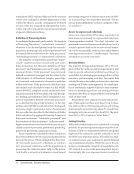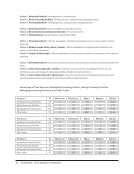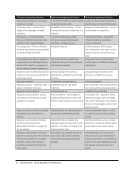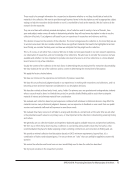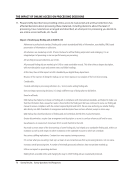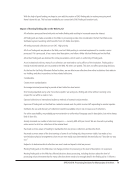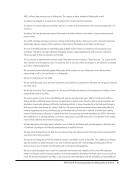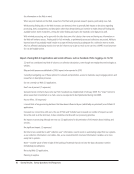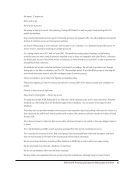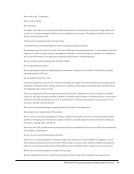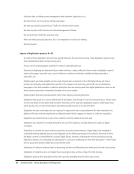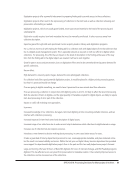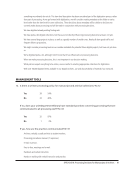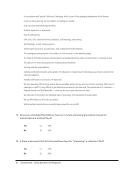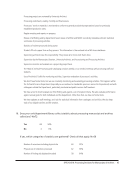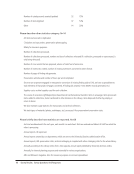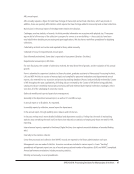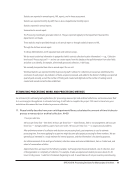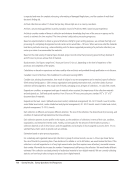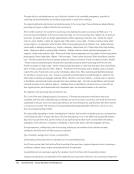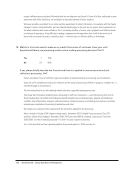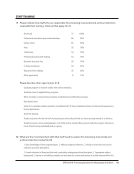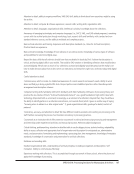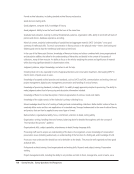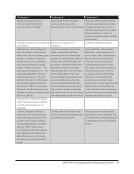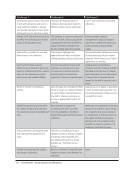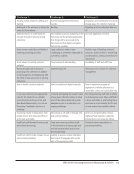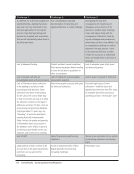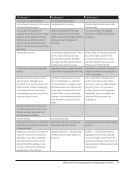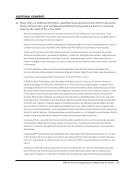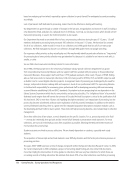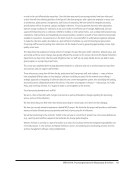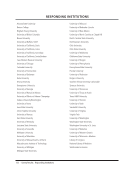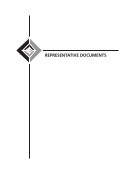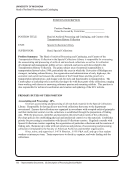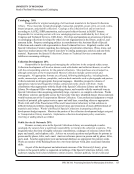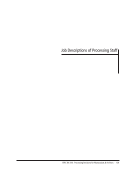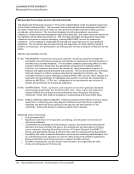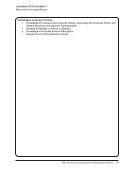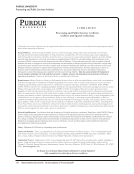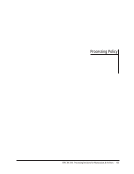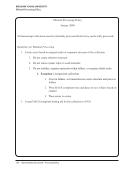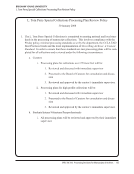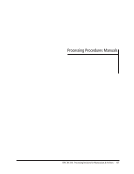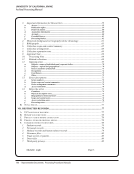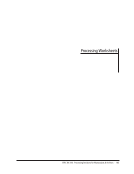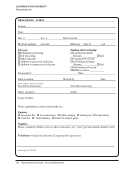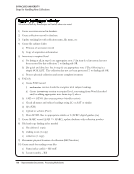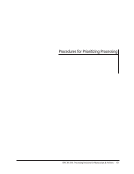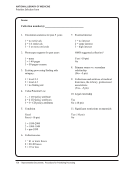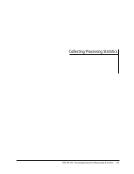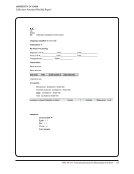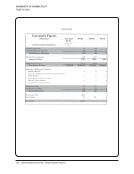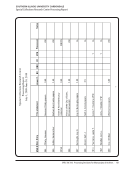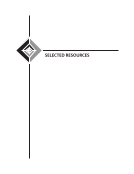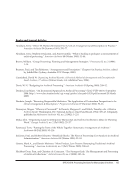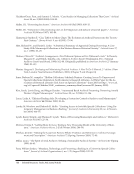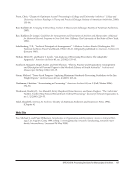SPEC Kit 314: Processing Decisions for Manuscripts &Archives · 61
The default is folder level, but we assess the level of processing for each collection.
The folder level is the most common level in the CSWR, however within a collection we also do series descriptions.
Usually we include series information and then file-level information, but it depends on the size, complexity, and content
of the collection.
We almost never go beyond the folder level. We’re currently working on digitizing a complete collection with an NHPRC
grant, but that is also only folder-level description.
We customarily process to folder level. In some cases, most often in photograph collections and in collections that
include (or consist of) printed ephemera, we describe at the item level. For manuscript collections consisting of a single
item, we ordinarily create an item-level MARC record.
We have done all four types of processing at different times and for different reasons. We are presently engaged in
generating at least collection-level records for all 2000+ of our collections. Our policy for new collections is to create a
collection-level description with corresponding MARC record immediately upon accession. If possible we will also do a
series-level description. Folder-level processing is prioritized based on a variety of factors, and the vast majority of our
inventories are done to the folder level. We rarely perform item-level processing though some of our collections that
were done years ago are item level, today it would be done only in unusual circumstances (e.g., such access is required
to make the collection useful to researchers). We have no problem with different parts of a collection having different
levels of description, as appropriate.
We have often described at a consistent level throughout the collection, sometime we describe at the series and box
levels rather than the folder level in cases where the materials are rather undifferentiated or homogeneous.
We have processed and described the correspondence series to item level for a particular collection other series are
processed and described to the folder level for this collection.
We may use all of the levels within a given collection if warranted.
We most frequently process to the folder level. We may process at the series or collection level for collections, or parts
of collections, that we expect to be infrequently used. If our assessment is wrong and the collection is used, then we
can do additional processing. We very rarely process at the item level. Any level may be used for any part of a collection.
Most frequently, a whole series would be described at any one level.
We no longer process at the item level with the exception of images, but it had been done in the past at this institution.
Most full collection processing will go to the folder level. In recent years, we have decided to strategically process at the
collection, series, or folder level as expected/known research demands indicate.
We rarely use item-level cataloging any more folder level consists of folder titles used in the container lists.
We use all levels needed to make the materials usable.
We use all levels of description. Item level is used only for very important material.
We usually use series and folder, but in our Manuscripts unit we sometimes use series, folder, and item level.
Within a collection only one level is used.
Within a collection we process to the series level if it has high demand or probably will have high usage and is worthy
of a preliminary inventory. If we process at the collection level, the materials get either a summary description or a full
preliminary-inventory with folder-level control.
The default is folder level, but we assess the level of processing for each collection.
The folder level is the most common level in the CSWR, however within a collection we also do series descriptions.
Usually we include series information and then file-level information, but it depends on the size, complexity, and content
of the collection.
We almost never go beyond the folder level. We’re currently working on digitizing a complete collection with an NHPRC
grant, but that is also only folder-level description.
We customarily process to folder level. In some cases, most often in photograph collections and in collections that
include (or consist of) printed ephemera, we describe at the item level. For manuscript collections consisting of a single
item, we ordinarily create an item-level MARC record.
We have done all four types of processing at different times and for different reasons. We are presently engaged in
generating at least collection-level records for all 2000+ of our collections. Our policy for new collections is to create a
collection-level description with corresponding MARC record immediately upon accession. If possible we will also do a
series-level description. Folder-level processing is prioritized based on a variety of factors, and the vast majority of our
inventories are done to the folder level. We rarely perform item-level processing though some of our collections that
were done years ago are item level, today it would be done only in unusual circumstances (e.g., such access is required
to make the collection useful to researchers). We have no problem with different parts of a collection having different
levels of description, as appropriate.
We have often described at a consistent level throughout the collection, sometime we describe at the series and box
levels rather than the folder level in cases where the materials are rather undifferentiated or homogeneous.
We have processed and described the correspondence series to item level for a particular collection other series are
processed and described to the folder level for this collection.
We may use all of the levels within a given collection if warranted.
We most frequently process to the folder level. We may process at the series or collection level for collections, or parts
of collections, that we expect to be infrequently used. If our assessment is wrong and the collection is used, then we
can do additional processing. We very rarely process at the item level. Any level may be used for any part of a collection.
Most frequently, a whole series would be described at any one level.
We no longer process at the item level with the exception of images, but it had been done in the past at this institution.
Most full collection processing will go to the folder level. In recent years, we have decided to strategically process at the
collection, series, or folder level as expected/known research demands indicate.
We rarely use item-level cataloging any more folder level consists of folder titles used in the container lists.
We use all levels needed to make the materials usable.
We use all levels of description. Item level is used only for very important material.
We usually use series and folder, but in our Manuscripts unit we sometimes use series, folder, and item level.
Within a collection only one level is used.
Within a collection we process to the series level if it has high demand or probably will have high usage and is worthy
of a preliminary inventory. If we process at the collection level, the materials get either a summary description or a full
preliminary-inventory with folder-level control.












